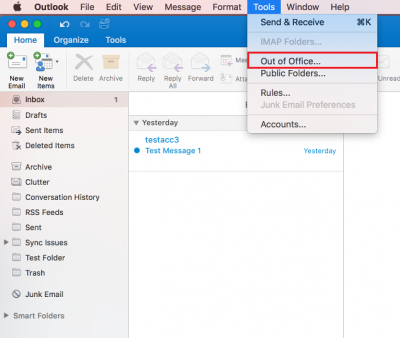
Select the address you want to redirect the message to by double-clicking the contact in the contact list. In this case, select Forward, redirect or send then Redirect the message toĥ. Select the action(s) that you want the rule to take when the specified conditions are met.ĭo all of the following: click on the drop-down box to reveal a list of actions to take. In this case, select My name is and in the To or Cc box. When the message arrives, and it matches all of these conditions: click the drop-down box to reveal a list of conditions and. Select the condition(s) you want the incoming message to meet (match) for the rule to apply. You can also type Inbox Rules in the Search all settings field.ģ. On the left-hand menu, select Options tab > Mail > Automatic Processing then Inbox and Sweep rules Choose Settings (gear icon at the top right corner) then select Mail shortcut aleft-handtom right corner. Enter your user name and password, and then click Sign in.ġ. In a Web browser, sign in to Outlook Web App using the URL provided by the person who manages email for your organisation or at. Set Up Email Redirect with Outlook Web Appġ. – to delete a rule, click Delete then click Apply – to Edit Rule Settings / Rename, click Change Rule and then click Apply. To turn off the rule, un-tick the check box next to the rule name. Your new redirecting rule appears in the list shown on the Rules and Alerts dialog box with a summary of the action and condition under Rule description.ġ0. If you want this rule to be effective immediately then ensure the Turn on this rule check box is tickedĩ. Under Step 2: Set up rule options, select the check boxes for the options that you want. Under Step 1: Specify a name to this rule, type a name Finish rule setup dialog box will appear. Click the underlined value, and select or type the necessary information for the condition.Ĩ. The selected condition will appear in the box Step 2: Edit the rule description (click an underlined value). If there are exceptions, under Step 1: Select condition(s), tick the checkbox next to the exception condition(s). Tick the check box if there is any exception to the rule. The selected contact or public group will appear in the To–> box.ħ. In the contact list, double-click the contact or public group. You can search the contact where the email will be redirected to by name. The selected action will appear in the box Step 2: Edit the rule description (click an underlined value)Ĭlick on “people or public group” under Step 2, a Rule Address dialog box will open. In this case, under Step 1: Select action(s), select “redirect it to people or public group”. Select the action(s) that you want the rule to take when the specified conditions are met. If you choose a condition with a blue underlined value, specify the value by clicking on the underlined text.Ħ. In this case, under Step 1: Select condition(s), select “where my name is in the To or Cc box”.

Tick the check box next to each condition that you want the incoming message to meet (match) for the rule to apply. In the Rules Wizard, under Start from a blank rule, click Apply rule on message I receive, and then click Next.ĥ.


In the Rules and Alerts dialog box, on the Email Rules tab, choose New Rule.Ĥ. From the Account Information window, select Info tab and then Manage Rules and Alertsģ.
#Best set up to find all sent emails in outlook 365 for mac how to#
This blog will show you how to set up Inbox Rule to achieve this using either method. You can use the local Outlook application or the Outlook Web App via a browser. There are two methods to set up an Email Redirect when using Microsoft’s Office 365. You can use Outlook Inbox Rules to redirect any messages you received that match conditions specified in the Rule to another email account.

This blog outlines how to set up email redirect in Outlook and Outlook Web App (OWA)


 0 kommentar(er)
0 kommentar(er)
